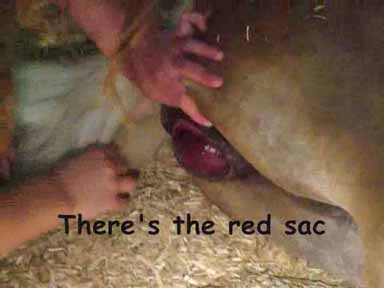This article explains red bag delivery. Sorry so Long
Red bag deliveries, or premature placental separations, are frightening, even after you've seen several. The foal is in immediate threat of suffocation. Unless someone is standing by, ready and knowledgeable enough to assist, its young life will end in the next few minutes.
The mare herself is in no particular danger, unless the foal is improperly positioned. Usually, the foal, placenta and all, will be delivered normally. The foal, trapped within the thick sack that it is unable to break, will perish. But if you know how to assist, its life can usually be saved.
The most important thing to remember in a red bag delivery is that there is not a minute to spare. The placenta, which has been supplying the foal with oxygen throughout its gestation, is no longer doing so. The foal will soon start trying to breathe, but it will inhale only fluids, not air. It must be delivered quickly if it is to have a chance at survival.
One of the most difficult things about a red bag delivery is breaking open the placenta. It is tough and slippery, and almost impossible to tear with your bare hands. A knife would do it, but could be dangerous to mare or foal should it slip, or should it be dropped in the bedding when you have your hands full of foal. I have found that one of the best tools for cutting the placenta is inexpensive and safe. I use a "craft stick" (also known as a tongue depressor) cut off on one end at a sharp angle. You can buy bags of these at any craft store or craft department. A heavy pair of scissors will cut them. You want a sharp point. Stick several of these in your foaling kit. As soon as you see the red bag, even before it begins to emerge, use one to slice the bag open. Immediately reach into the mare and feel for the water bag. Cut it open, too. Then, drop the stick and reach in for the foal.
Do you feel two hooves and a nose? If so, grasp the front feet and pull in time with the mare's contractions. You must get the foal out quickly if you're going to save it, but don't injure your mare in the process. Once you get the front feet out a few inches, stagger them so that one is ahead of the other and continue to pull. Remember to always pull the foal down towards the mare's hocks, not straight out. Do not wait for the mare to push the foal out by herself. Remember that the foal is not getting oxygen!
As soon as you have gotten the body delivered, and the foal's chest is no longer constricted by the birth canal, make sure it starts to breathe. You will likely hear gurgling sounds from the fluid it has inhaled. Gently squeeze some of the moisture out by holding the bridge of the nose between thumb and forefinger and sliding your hand down towards its nostrils. If you have a towel handy, this will help as well. Stimulate the baby by vigorously rubbing it and by scratching the ticklish spot in the middle of its back. It should begin to try to raise its head. If the foal is still not breathing well, or still gurgling, now is a good time to call the vet. If you have someone with you, have him or her do it so you can continue to assist the foal. You may have to pick it up by its back feet and let some of the fluid drain from its lungs.
Don't give up! I've seen some foals that looked nearly dead survive. Keep stimulating the foal until its breathing improves and it starts trying to get up. Then, pull it around to the mare so that she can stimulate it herself. But keep a close eye on it until your vet arrives.
A friend's miniature mare recently had her second red bag delivery in two years. Fortunately, we were present both times and saved the foals. I consulted our equine vet shortly after the last one. One cause of red bag deliveries, he told me, was thought to be a premature opening of the cervix. This allows bacteria to invade the uterus and the placenta becomes infected. He said that in the case of a mare who has red bagged more than once, he would recommend starting her on oral antibiotics, such as SMZ or Metronidazole, one month before due date. He said that in some cases, he will go in vaginally and infuse an antibiotic as well. Hopefully, if the infection can be stopped, the premature separation of the placenta can be avoided. I recommend you consult your own veterinarian and follow his advice.
Red bag deliveries are, fortunately, not common. But they can and do happen. By preparing yourself --- and your foaling kit --- you can keep them from being a disaster.




